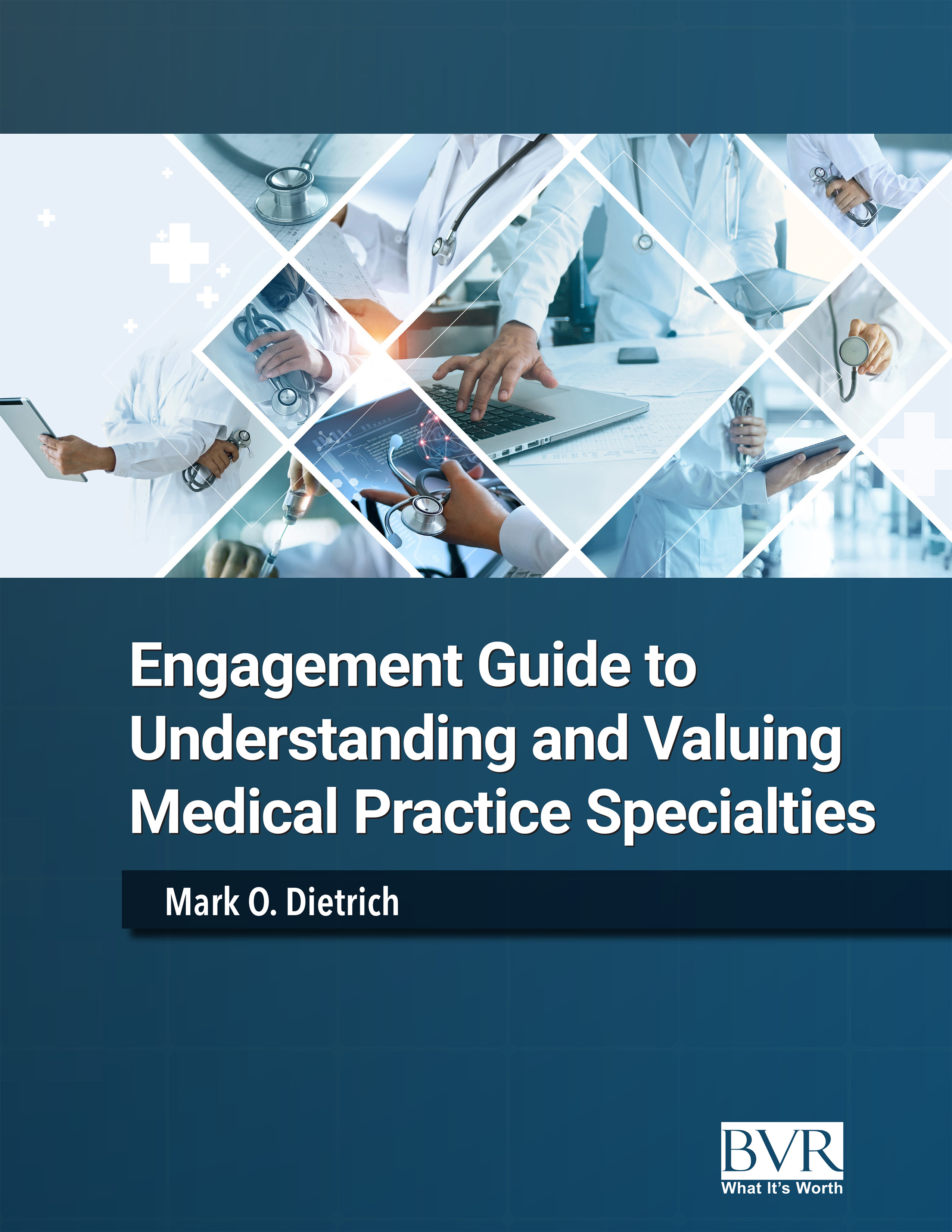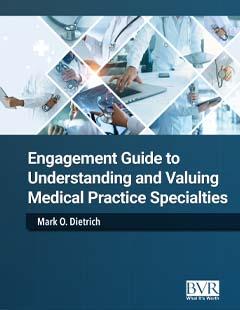Engagement Guide to Understanding and Valuing Medical Practice Specialties
April 2023 Hardcover, PDF (396 pages)
Mark Dietrich
Business Valuation Resources, LLC
Mastering the numerous physician specialty services is an especially nuanced and challenging aspect of medical practice valuations. Mark Dietrich’s new Engagement Guide to Understanding and Valuing Medical Practice Specialties delivers the hands-on, practical guidance any practitioner needs to complete the most accurate conclusions possible. This unique Guide is the first of its kind. Healthcare valuation guru Mark Dietrich provides actual insight into various specialties with examples from actual valuations. His tutorial will help you:
- Clearly grasp the payer mix — Each chapter outlines what portion of revenues come from insurers vs. direct patient payments.
- Determine reasonable compensation — Every chapter includes a comprehensive calculation of reasonable compensation using a relative value unit (RVU) calculator.
- Take capitalization of cash flow to a new height — Each chapter summarizes AR by various insurers. Get new insight into calculating collections and understanding what percentage of a practice’s charges the insures pay. Dietrich includes an example for each practice.
Dietrich’s goal with this guide is to support the experienced business valuation generalist in enhancing the necessary skills for a medical specialty practice engagement.
Complete your valuation library with the Engagement Guide to Understanding and Valuing Medical Practice Specialties!
- Gain greater insight - Unique author's insight included in certain chapters helps give you the bigger picture on the topics at hand.
- Learn interview tips from the pros - The guide’s final chapter is an engagement aid on how to conduct the management interview, complete with detailed
explanations for each interview item. This is one of the most useful and practical aspects of this guide. - Gain different perspectives - This guide is designed to meet the needs of a range of valuation needs from business valuators to litigation experts - this guide has valuable insights for everyone!
- See the bigger picture - this guide is specifically designed to be used in tandem with other BVR guides including Guide to Physician Practice Valuation, 3rd Edition.
- Get the essential data - This isn't a general reference guide, this publication is meant to zero in on exactly what you need to value specific types of medical practices.
- Benefit from real-world experience - Author Mark Dietrich has over 40 years of medical practice valuation experience having worked as the outside auditor for what was then the largest of the Harvard Medical School’s Faculty Group Practices
Goal of the Guide
Using the Guide
How the Specialties Were Chosen
Specialty-Specific Elements
Payer Mix
Relative Value Unit (RVU) Calculation and Reasonable Compensation
Cost of Capital
Profit and Loss and Cash-Flow Analysis
Normalization Adjustment
Capitalization of Cash Flow (CCF)
About the Author
Acknowledgements
Chapter 1. Understanding and Valuing Dermatology Practices1.0 Introduction to Valuing Dermatology Practices
2.0 Sources of Fee Income
3.0 Medicare Conversion Factor
4.0 Sample CPT© Revenue Analysis
5.0 Payor Mix
7.0 Sample Practice RVU Analysis
8.0 Reasonable/Replacement Compensation Analysis
9.0 Private Equity in Dermatology
10.0 Cost of Capital
11.0 Terminal Growth Rate
12.0 Valuation Purpose Nuances
13.0 Normalization Adjustments
14.0 Summary Valuation
15.0 Conclusion
Appendix 1A. RVU Calculation—Dermatology Practice (All Providers Combined)
Appendix 1B. RVU Calculation—Dermatology Practice (Physicians)
Appendix 1C. RVU Calculation—Dermatology Practice (Physician Assistants)
Chapter 2. Understanding and Valuing Gastroenterology Practices
1.0 Introduction to Valuing Gastroenterology Practices
2.0 Sources of Fee Income
3.0 Medicare Conversion Factor
4.0 Sample Practice CPT© Analysis
5.0 Analysis of Office Visit Coding Variability
6.0 Payer Mix
7.0 Nurse Practitioners and Physician Assistants
8.0 RVU Analysis
9.0 Reasonable/Replacement Compensation Analysis
10.0 Private Equity in Gastroenterology
11.0 Cost of Capital
12.0 Terminal Growth Rate
13.0 Normalization Adjustments
14.0 Summary Valuation
15.0 Conclusion
Appendix 2A. RVU Calculation—Gastroenterology Practice (All Providers Combined)
Chapter 3. Understanding and Valuing Internal Medicine Practices
1.0 Introduction to Valuing Internal Medicine Practices
2.0 Sources of Fee Income
3.0 Medicare Conversion Factor
4.0 Sample CPT© Revenue Analysis
5.0 Payer Mix
6.0 Evaluating Advanced Practice Providers: Nurse Practitioners and Physician Assistants
7.0 Sample Practice RVU Analysis
8.0 Reasonable/Replacement Compensation Analysis
9.0 Private Equity in Primary Care
10.0 Cost of Capital
11.0 Terminal Growth Rate
12.0 Normalization Adjustments
13.0 Summary Valuation
14.0 Conclusion
Appendix 3A. RVU Calculation—Internal Medicine Practice (All Providers Combined)
Appendix 3B. RVU Calculation—Internal Medicine Practice (Physicians)
Appendix 3C. RVU Calculation—Internal Medicine Practice (Nurse Practitioners)
Chapter 4. Understanding and Valuing OB-GYN Practices
1.0 Introduction to Valuing OB-GYN Practices
2.0 Sources of Fee Income
3.0 Medicare Conversion Factor
4.0 Sample CPT© Revenue Analysis
5.0 Nurse Practitioners and Physician Assistants
6.0 RVU Analysis
7.0 Reasonable/Replacement Compensation Analysis
8.0 Private Equity in Women’s Health
9.0 Cost of Capital
10.0 Terminal Growth Rate
11.0 Normalization Adjustments
12.0 Summary Valuation
Conclusion
Appendix 4A. RVU Calculation—OB-GYN Practice (All Providers Combined)
Chapter 5. Understanding and Valuing Ophthalmology and Retina Surgery Practices
1.0 Introduction to Valuing Ophthalmology and Retina Practices
2.0 Sources of Fee Income
3.0 Medicare Conversion Factor
4.0 Summary CPT© Analysis by Major Category, Ophthalmic Group Practice
5.0 Sample CPT© Analysis, Two-Person Retina Practice
6.0 Payer Mix
7.0 Ophthalmic Assistants, Nurse Practitioners, and Physician Assistants
8.0 Sample Practice RVU Analysis
9.0 Reasonable/Replacement Compensation Analysis
10.0 Private Equity in Ophthalmology
11.0 Cost of Capital
12.0 Terminal Growth Rate
13.0 Normalization Adjustments
14.0 Summary Valuation
15.0 Conclusion
Appendix 5A: Lookup Table
Appendix 5B. RVU Calculation—Ophthalmology and Retina Surgery Practice (Physicians)
Chapter 6. Understanding and Valuing Orthopaedic Surgery Practices
Introduction to Valuing Orthopaedic Surgery Practices
1.0 Orthopaedic Subspecialties
2.0 Gender
3.0 Sources of Fee Income
4.0 Medicare Conversion Factor
5.0 Sample CPT© Revenue Analysis
6.0 Payer Mix
7.0 Evaluating Advanced Practice Providers: Nurse Practitioners and Physician Assistants
8.0 RVU Analysis
9.0 Reasonable/Replacement Compensation Analysis
10.0 Private Equity in Orthopaedic Surgery
11.0 Cost of Capital
12.0 Terminal Growth Rate
13.0 Normalization Adjustments
14.0 Summary Valuation
Conclusion
Appendix 6A. RVU Calculation—Orthopaedic Surgery Practice (All Providers Combined)
Appendix 6B. RVU Calculation—Orthopaedic Surgery Practice (Physicians)
Appendix 6C. RVU Calculation—Orthopaedic Surgery Practice (Physician Assistants)
Chapter 7. Understanding and Valuing Pediatric Practices
Introduction to Valuing Pediatric Practices
1.0 Pediatric Subspecialties
2.0 Male and Female Pediatricians
3.0 Sources of Fee Income
4.0 Medicare Conversion Factor
5.0 Sample CPT© Revenue Analysis
6.0 Payer Mix
7.0 Evaluating Advanced Practice Providers: Nurse Practitioners and Physician Assistants
8.0 Sample Practice RVU Analysis
9.0 Reasonable/Replacement Compensation Analysis
10.0 Private Equity in Primary Care
11.0 Cost of Capital
12.0 Terminal Growth Rate
13.0 Normalization Adjustments
14.0 Summary Valuation
15.0 Conclusion
Appendix 7A. RVU Calculation—Pediatric Practice (All Providers Combined)
Appendix 7B. RVU Calculation—Pediatric Practice (Physicians)
Appendix 7C. RVU Calculation—Pediatric Practice (Physician Assistants)
Chapter 8. Understanding and Valuing Urology Practices
Introduction to Valuing Urology Practices
1.0 Urology Subspecialties
2.0 Sources of Fee Income
3.0 Medicare Conversion Factor
4.0 Sample Practice CPT© Analysis
5.0 Analysis of Office Visit Coding Variability
6.0 Payer Mix
7.0 Nurse Practitioners and Physician Assistants
8.0 RVU Analysis
9.0 Reasonable/Replacement Compensation Analysis
10.0 Private Equity in Urology
11.0 Cost of Capital
12.0 Terminal Growth Rate
13.0 Normalization Adjustments
14.0 Summary Valuation
15.0 Conclusion
Appendix 8A. RVU Calculation—Urology Practice (Physicians)
Appendix 8B. RVU Calculation—Urology Practice (Doctor 3)
Appendix 8C. RVU Calculation—Urology Practice (Doctor 4)
Chapter 9. Observations on Other Specialties
1.0 All Practices
2.0 Cardiology
3.0 Neurology
4.0 Nephrology
Chapter 10. The Physician Practice Interview and Site Visit
Overview of Practice Interview Outline
Practice Background
Operational Questions
Employees
Physical Site Visit
Other Data
Practice Valuation Questionnaire
APPENDICES
Sample Valuation Report: Orthopaedic Surgery Practice
Practice Overview
Special Issues in the Discussion of the Economy and Industry
Valuation Discussion and Conclusion
Revisiting the Meaning of Fair Market Value
Physician Distribution, Mobility, Fair Market Value, and Compensation Surveys
Mobility Considerations
Summary of Regional Findings
Differences in Regional Trends
Comparison With MGMA Data
Impact on Physician Practice Valuation
Impact on Physician Employment Compensation Valuation
Conclusions
Physician Distribution, Mobility, Fair Market Value, and Compensation Surveys: An Update
Some Examples of Actual Physician State of Location vs. MGMA Data
December 2020 Changes in the Stark Regulations
A Lesson in Healthcare Supply and Demand—and Market Power (Part 1)
Understanding Health Insurance Markets
A Lesson in Healthcare Supply and Demand—and Market Power (Part 2)
Geographic Concentration of Physicians and Disparity in Insurer Payments
Market Studies of Provider Prices
Conclusion

